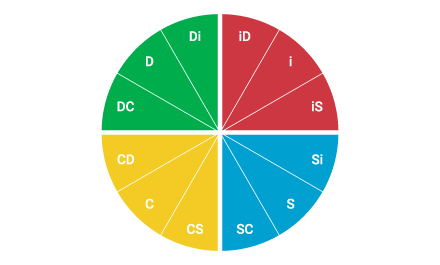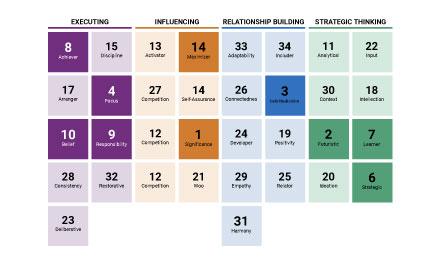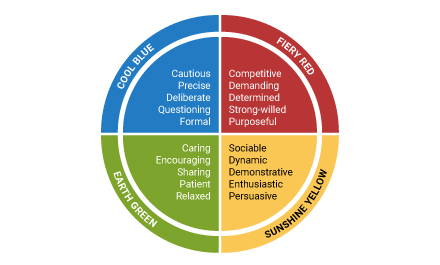So, you’re looking for an assessment-based learning experience, but there are hundreds of options! What are they? And how do you choose the right one for your organization?

Spending time answering these questions is critical to achieving your desired result. Why? Because the most well-known assessments on the market differ in many foundational ways—some are optimized for self-insight while others for hiring. Some are designed to be simple, while others are more complex. Some prioritize reliability and validity while others do not. Selecting the right assessment depends on your understanding of your organization’s needs AND the different dynamics of each offering.
To help you get started, we’ve created a summary of five well-known assessment-based learning experiences. You’ll discover each assessment’s purpose, level of complexity, foundational model, research approach, details around the broader learning experience, and more. Because, when it comes to investing in your greatest asset—your people—you can’t afford to go wrong.
A Comparative Summary
Brand

Purpose

Complexity

Model

Research

Assessment
Results and
Profile

Expanded
Digital
Experience

Detailed Comparison
Purpose
Each assessment-based learning experience is optimized for a specific goal or outcome. This section covers the primary objective of each assessment.

Everything DiSC®: Relationship & Culture Building
Everything DiSC® is optimized for relationship and culture building in the workplace. It helps people better understand themselves and others by providing rich, personalized insights about themselves alongside actionable strategies for applying those insights to their everyday interactions. A core goal of the program is to create a common language among team members that can be used to have safe, empathetic conversations around interpersonal differences. Because the model is simple, learners can easily remember the four DiSC® styles and use that language to talk about issues that might otherwise be too subtle or sensitive.

CliftonStrengths®: Self-Insight
CliftonStrengths® is optimized for self-insight. The goal of the learning experience is to help people understand what they are particularly good at and how they can take full advantage of those strengths in their work lives. The program emphasizes how each participant is unique and gives them access to tips on how they can use their strengths in their everyday lives to be more effective.

MBTI®: Self-Insight
MBTI® is optimized for self-insight. It identifies which of 16 different personality types is the best fit for a learner and uses this “type” to help learners understand their preferences, strengths, and challenges. This insight can then be used to better understand their behavior in specific contexts, like how they approach conflict or handle change.

Predictive Index® (PI): Hiring
Predictive Index® is optimized for hiring and selection. The core tools are designed to help organizations better understand the fit between a candidate and a job. Candidates are measured on five personality dimensions and those dimensions are matched against the job requirements so that the organization can make an informed choice.

Insights Discovery®: Relationship & Culture Building
Insights Discovery® is optimized for relationship and culture building. The goal of the Insights Discovery® approach is to help people better understand themselves and the people around them. With that knowledge, people can better connect with their colleagues because they have a common language to discuss challenges and conflicts.
Complexity
This section covers the complexity of each tool and defines how easy or difficult the principles of the experience are for learners to understand, internalize, and apply.


Everything DiSC®: Simple
The Everything DiSC® experience is intentionally designed to be simple and user friendly so learners can exhibit lasting change. The core model describes four intuitive quadrants, which learners can understand within minutes. Learners are presented with a single DiSC style out of a possible 12 styles, offering them a powerful framework that ensures what is learned is readily applied.

CliftonStrengths®: Simple
CliftonStrengths® is a straight-forward experience for learners; they are presented with ten out of a possible 34 strengths that are most pronounced for them. These strengths are written to be intuitive and self-explanatory, with commonsense tips for application. Users are not encouraged to learn the entire model.

MBTI®: Complex
The MBTI® presents four dichotomies, such that learners are required to learn and retain the meaning of eight letters (i.e., E, I, S, N, T, F, J, P). The various combinations of these preferences result in 16 types, in contrast to the four styles taught within DiSC or the four-color energies taught within Insights Discovery®. This complex framework makes conversations about type more difficult after a learning session. In addition, many MBTI® reports explain an aspect of the types model called “types dynamics,” which many learners experience as complicated.

Predictive Index® (PI): Simple
The PI offering is designed to be short and simple; such that hiring managers can quickly get the information they need to determine whether the candidate is a good fit for the job. The personality section of the tool focuses on five easy-to-understand dimensions that should be intuitive to most employees.

Insights Discovery®: Simple
The Insights Discovery® offering is designed to be straight-forward, delivered to learners in plain language. The learner’s profile makes relatively few mentions of their personality model (i.e., the four-color energies), but instead focuses on a practical interpretation of results. The four-color energies are simple and intuitive for learners to grasp.
Model
The theoretical model used within a tool has significant implications for the learning experience. Ultimately, these models define what topics will and will not be covered within that experience. They also create a simple, common language that help users talk about abstract psychological topics. Each model carries its own history, assumptions, strengths, and limitations.

Everything DiSC®
The Everything DiSC® model is presented as a circle with four quadrants, each representing a cluster of personality traits. The four quadrants are:
- Dominance (D; direct and forceful)
- Influence (i; outgoing and expressive)
- Steadiness (S; patient and accommodating)
- Conscientiousness (C; analytical and precise)
Although the model was originally inspired by the work of William Marston, its current manifestation has much more in common with a model called the interpersonal circumplex. In both models, people mapped toward the top of the circle/circumplex are relatively fast-paced and assertive. People mapped toward the bottom are relatively cautious and reflective. People mapped toward the left are relatively questioning and skeptical. People mapped toward the right are relatively warm and accepting. To better understand the meaning of their placement within the DiSC circle, respondents are assigned one of 12 styles. The model is intuitive and easy to remember, helping people understand themselves and others quickly, enabling real-time adaptation to each other’s preferences and tendencies.


CliftonStrengths®
The CliftonStrengths® model is based on the research of Don Clifton, which identified 34 strengths. These strengths, in turn, are organized into four domains of leadership strength: Executing, Influencing, Relationship, and Strategic. It is not expected that all a person’s strengths will fall into a single domain, but one or two domains may be prominent for them. The philosophy behind the model encourages learners to spend most of their energy finding opportunities to better take advantage of their strengths, rather than spending that energy to shore up their weaknesses.


MBTI®
The MBTI® model is built on the work of Carl Jung and categorizes people’s preferences in four dichotomies:
- The first dichotomy, Introversion(I)/Extraversion(E), notes where a person gets their energy from—the internal world or the external world.
- The second dichotomy, Sensing(S)/Intuition(N), asks what type of information a person is most likely to pay attention to—concrete information taken in through the senses or abstract information like theories and symbols.
- The third dichotomy, Thinking(T)/Feeling(F), asks how a person makes decisions—objectively through logic or subjectively with a focus on compassion.
- The final dichotomy, Judging(J)/Perceiving(P), reflects the level of structure someone prefers—gravitating toward closure or gravitating toward remaining open.
The interaction among these dichotomies is articulated in the theory of type dynamics. In this theory, the four dichotomies are taken together to represent a person’s type, of which there are 16 possible combinations. This type describes a holistic view of the person.

Predictive Index® (PI)
The five dimensions measured in the PI model are:
- collaborative/independent
- reserved/social
- driving/steady
- flexible/precise
- subjective/objective
The first four of these dimensions are conceptually very similar to the four quadrants of the DiSC® model. The respondent’s scores on the dimensions are also considered collectively and presented in an overall snapshot of the person, which is categorized as one of 17 Reference Profiles.

Insights Discovery®
The four “color energies” within the Insights Discovery model are conceptually very similar to the four quadrants of the DiSC® model. The four-color energies each represent a different set of personal characteristics:
- Fiery Red (competitive and demanding)
- Sunshine Yellow (sociable and dynamic)
- Earth Green (caring and encouraging)
- Cool Blue (cautious and precise)
These color energies branch to form eight personality types, which are often displayed on a circle, called the Type Wheel. The foundations of the model are linked to the Jungian preferences (introverted/extraverted, intuition/sensing, thinking/feeling).

Research
Psychological instruments, that are the centerpiece of assessment-based learning experiences, are used to measure abstract qualities that we can’t touch or see. These are characteristics like intelligence, extroversion, or honesty. Research helps you evaluate these instruments so that you can determine if the information will be useful and accurate for your learners. Although no psychometric tool is perfect, reliability and validity have been established by the scientific community as the best way to determine if a tool is efficacious.
- Reliability: Does the assessment consistently produce the same results across time?
- Validity: Does the assessment measure what it proposes to measure?

Everything DiSC®
The eight Everything DiSC® scales demonstrate strong reliability with a median two-week test-retest reliability of .86. Strong evidence for the validity of the scales is demonstrated through correlations with other established personality assessments (e.g., NEO-PI-3, 16PF). The D scale, for instance, correlates .63 with the Dominance scale of the 16PF and -.63 with the Compliance scale of the NEO-PI-3.
Validity of the assessment is also demonstrated through correlations with observer ratings of the respondent’s behavior. For instance, respondent’s D scale scores correlate most positively with observing ratings of Showing Confidence and Taking Charge and correlate most negatively with observer ratings of Showing Modesty and Showing Diplomacy. This is as expected under the theory.
Analyses also show that respondents rate passages of text describing their assigned style as significantly more like them than passages of text describing other styles. For example, 88% of respondents assigned the D style rated a passage of D text as highly like them and 16% rated a passage of S text (conceptually opposite the D style) as highly like them. These ratings were made blindly, before respondents were told their assigned DiSC style. The rigor placed on demonstrating reliability and validity of the Everything DiSC tool has resulted in a 90% learner accuracy rating worldwide.

CliftonStrengths®
The reliabilities of the CliftonStrengths® scales tend to be lower than industry norms. The median internal reliability across 34 scales was .66, as published in their technical report (citation). Twenty-four scales fell below the traditional .70 cut-off and eight fell below .60. For reference, the median internal reliability across the eight Everything DiSC scales was .83 (citation).
The median eight-to-twelve-week test-retest reliability across 34 scales was .70, as published in their technical report (citation). Half of the scales fell below the traditional .70 cut-off and three fell below .60. These results suggest that CliftonStrengths® results will vary from testing to testing significantly more than is typical of most psychological assessments.
Correlations with the five-factor model of personality, show evidence of convergent validity for some scales. For instance, the Intellectence scale from a five-factor assessment correlated strongly with the CliftonStrengths® scales of Ideation (.70) and Strategic (.70). Other scales, however, failed to show evidence of discriminant validity. For instance, the Intellectence scale correlated strongly with the CliftonStrengths® scales of Self-Assurance (.53) and Command (.59) (citation).
1. Validity: Harter, J. K., & Hodges, T. D. (2003) Construct validity study: StrengthsFinder and the Five Factor Model [technical report]. Omaha, NE: The Gallup Organization.

MBTI®
The MBTI® scales demonstrate strong reliability, with a meta-analytic median test-retest of .81 (citation). Evidence for the validity of the scales has also been demonstrated through correlations with other assessments, correlations with behavior, and correlations with self-descriptions. (citation).
The theory behind the measurement, however, is frequently the target of academic criticism. Most notably, personality scholars object to the use of dichotomies within the types framework, such that, for example, a person is broadly categorized as either introverted or extraverted. In contrast, decades of personality research indicates that it is much more accurate to represent personality differences as existing on continua rather than as either/or dichotomies.
The use of dichotomies is necessary to support the theory of “type dynamics,” which is a second problematic element of types theory. Types dynamics describes an intricate interaction among four mental “functions,” resulting in dominant, auxiliary, tertiary, and inferior functions. Although the theory is too involved to describe here, personality researchers criticize that there is little direct empirical support for it.
1. Robert M. Capraro and Mary Margaret Capraro (2002, August) Educational and Psychological Measurement -WKU
2. The Myers-Briggs Company, Reliability and Validity of the MBTI® Instruments
3. David Pittenger (2005, June) Cautionary Comments Regarding the Myers-Briggs Type Indicator
4. James H. Reynierse (2009, January) The Case Against Type Dynamics

Predictive Index® (PI)
The reliabilities of the PI behavioral scales tend to be lower than industry norms, most likely because the assessment is so short (i.e., 6 minutes). The median two-week test-retest reliability across 13 scales (A through E) was .71, as published in the 2011 Predictive Index® Technical Overview (citation). Four scales fell below the traditional .70 cut-off and one was as low as .56. For reference, the median two-week test-retest reliability across the eight Everything DiSC® scales was .86. These results suggest that PI behavioral results will vary from testing to testing significantly more than is typical of most personality assessments.
Evidence for the validity of the personality scales is also mixed. For instance, PI reports moderately high but expected correlations between their Dominance scale and the IPIP scales of Domineering (.31) and Assertiveness (.50). But this Dominance scale also demonstrates positive correlations with Patience (.12) and Good-Nature (.17), where conceptually these correlations are expected to be at least moderately negative. That is, low scorers on the Dominance scale are conceptually described in the tool as agreeable, cooperative, and accommodating, but the reported correlations suggest that high scorers are actually more likely to have these traits.
In addition, the average reported correlation between job performance and PI behavioral scales is reported as ranging between .17 and .19 for the six scales. The US Department of Labor, however, lists scales as “likely to be useful” when they are above .21 and “very beneficial” when they are above .35 (citation).

Insights Discovery®
The Insights Discovery® has published a solid median test-retest reliability of .81 across its four scales, within a convenience sample ranging between three months and five years. The publisher also provides evidence of validity in the form of factor analytic work, correlations with other assessments, and correlations with rater assessments, among other methods.
The Insights Discovery® profile does, however, still report “conscious” and “less conscious” scales, based on a measurement theory that has no credible empirical support. This approach to measurement started in 1972 with the Personal Profile System (PPS), an early predecessor of the Everything DiSC profile. The theory proposes that an assessment can measure a person’s “natural” or “real” or otherwise unconscious self-concept by tallying question responses that they marked as “least like me” in a forced-choice questionnaire. This information could then be used to understand how a person acts when they are under stress. Further, the theory proposes that by examining question responses marked “most like me,” an assessment could determine a person’s “adapted self”—the personality that the respondent thinks others expect out of them or what kind of person the respondent thinks they should be. In the 1990s, the publisher of the PPS conducted research to evaluate the validity of this theory and concluded that there was no empirical support to justify the teaching of the theory.
In 1994, the publisher officially announced that it would no longer continue supporting this interpretation of the assessment on ethical grounds. It is worth noting that this method of measuring a person’s conscious/unconscious self is not accepted or promoted anywhere in academic or clinical psychology. Proponents of the theory often cite anecdotal evidence (e.g., “it feels right”), which personality researchers categorize as a cognitive error labeled the Forer Effect. Although proponents have sometimes cited highly indirect, tangential empirical evidence to justify the theory, there is still no direct, credible research to support its use, almost 50 years after its inception.
Assessment Results and Profile
Each assessment offers your learners their results in a personalized profile, reported in a PDF format. These results summarize the findings of the assessment, help the learner understand more about themselves, and provide insights to improve their impact at work. That said, the focus of each report differs across assessments. Below offers a summary to better understand these nuances.


Everything DiSC®
The Everything DiSC® profile is development-focused, guiding learners through a deliberate process of understanding themselves, understanding their colleagues, and bridging the gaps between the two with actionable strategies for improved interactions. The narrative-style content offers learners a common language that can be called upon long after the training session. Furthermore, the delivery of the content takes place on the Catalyst™ platform, connecting each learner to their colleagues and ensuring that the DiSC model is applied to learners’ real-world relationships and experiences. Each learning experience is beta tested with thousands of real classroom learners before being published.

CliftonStrengths®
The CliftonStrengths® reports are information-focused, helping learners understand their top ten strengths and information about those strengths. The report focuses on helping learners understand why they are unique, educating them about opportunities to capitalize on that uniqueness, and pointing out blind spots that might get them in trouble.

MBTI®
MBTI® reports are information-focused, with a range of different profiles for different purposes. Some profiles simply report on scale scores, while others offer more interpretation of results (i.e., the interpretive reports). The interpretive reports provide descriptions of the learner’s reactions to a variety of different situations, like communicating, managing conflict, dealing with change, and making decisions. Each of these sections also offers some brief tips on how to improve.

Predictive Index® (PI)
The PI reports tend to be both data-focused and short, usually one to three pages. The PI Behavioral Report, which is written for the respondent, is three pages long and begins with a graph showing the person’s scores on the five behavioral dimensions. On the next two pages, bullets describe the respondent’s strengths, management style, influencing style, and management strategies. The report is written in the third person, about the respondent rather than to the respondent.

Insights Discovery®
The flagship Insights Discovery® report is information-focused and 38 pages long. It starts with a general narrative description of the person and then focuses on describing the respondent in a variety of different contexts and situations, mostly through bulleted lists. There are, for instance, pages describing the respondent’s decision-making, blind spots, management style, sales approach, time management, and personal creativity. Most of the report does not reference their personality model (i.e., the four colors). As well, the report is written in the third person, about the respondent rather than to the respondent. The end of the profile contains three charts that report the respondent’s scale scores on the assessment.
Expanded Digital Experience
This section summarizes the digital experiences offered by each assessment.


Everything DiSC®
After taking their assessment, learners can explore their DiSC style on an online platform called Catalyst™. Catalyst acts as your learner’s home base throughout their DiSC journey—both in the facilitated session and in the real world. Here, learners can learn more about their personalities, but also can explore in-depth information and strategies about working better with their coworkers. For example, the Your Colleagues feature connects learners to each other, compares DiSC style information, describes how learners are similar and where they differ, and offers actionable strategies for navigating common workplace scenarios like collaboration or managing tension.

CliftonStrengths®
After taking their assessment, learners can download their reports from an online platform or read more about their strengths. The platform offers articles and videos for learners to view, and enables your learners to share their results with other people.

MBTI®
After taking their assessment, learners can explore their personality on an online platform, reading about their characteristics, strengths, and challenges. They can also compare their type to another learner’s type, getting bullet points on how the two of them differ and tips for developing the relationship. Finally, they can read a description of their team’s characteristics, strengths, and challenges.

Predictive Index® (PI)
Predictive Index® offers a limited digital experience that allows users to look up assessment results and get a summary of information about scale scores along with tips for real world application. A relationship guide is also available, allowing users to compare two individuals and presents 12 sentences that describe the relationship dynamics and how to improve them.

Insights Discovery®
Insights Discovery® does not offer a digital platform for learners to explore their results.
Summary
As you can see, each assessment-based learning experience differs from the next across a range of aspects. Yet, it’s the sum of these distinctions that offer differential value to your organization.
We believe that investing in your people is critical to your organization’s ability to navigate the post-pandemic workplace challenges with success. If you are seeking a new way to engage and connect your workforce in the hybrid working environment, Everything DiSC® is your best option. It combines the proven DiSC model with a powerful learning platform and flexible facilitation to improve workplace interactions at scale. As the original DiSC provider with 50 years of assessment-backed expertise and a 97% global satisfaction rating, you can rest assured your investment will have an immediate and lasting impact on the performance of your people and the culture of your organization.
